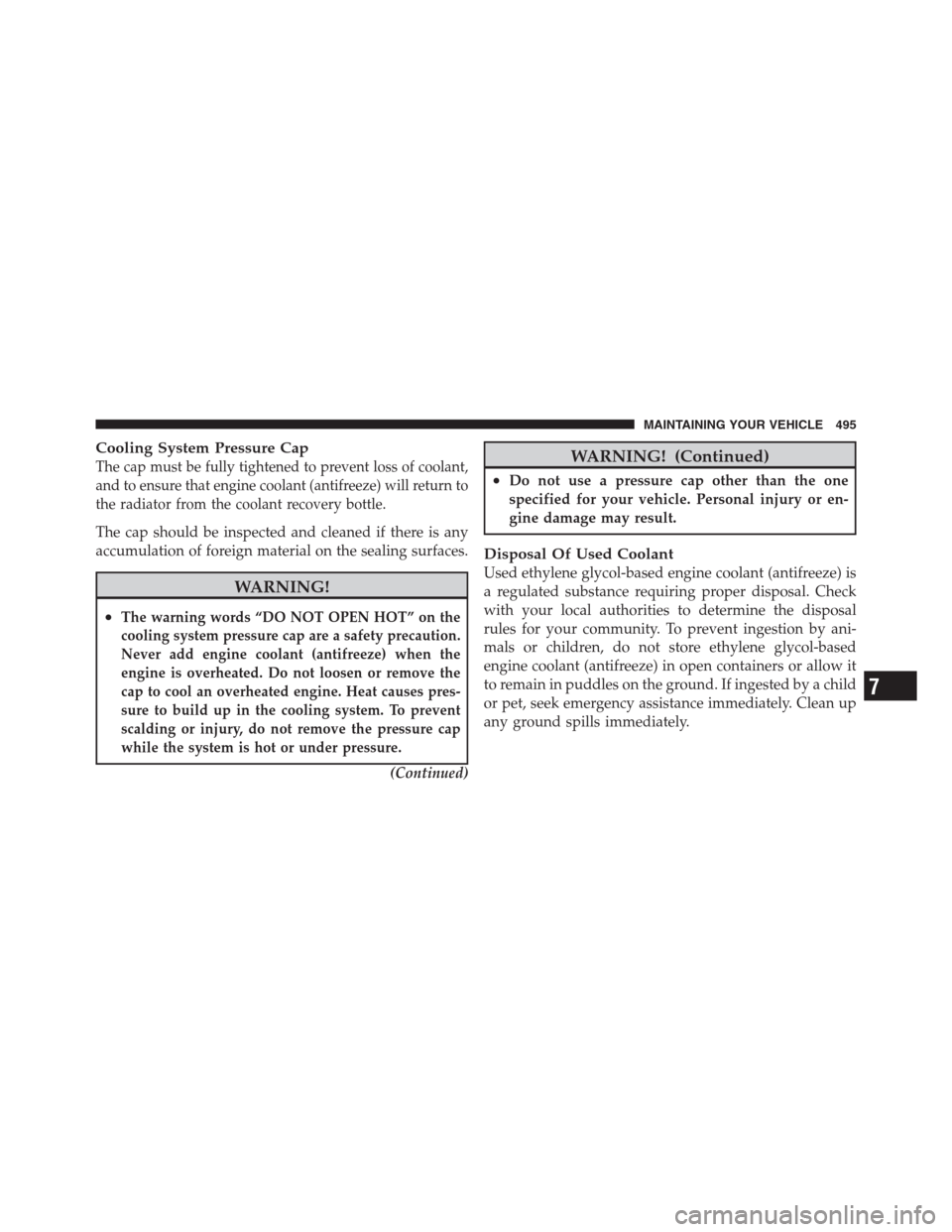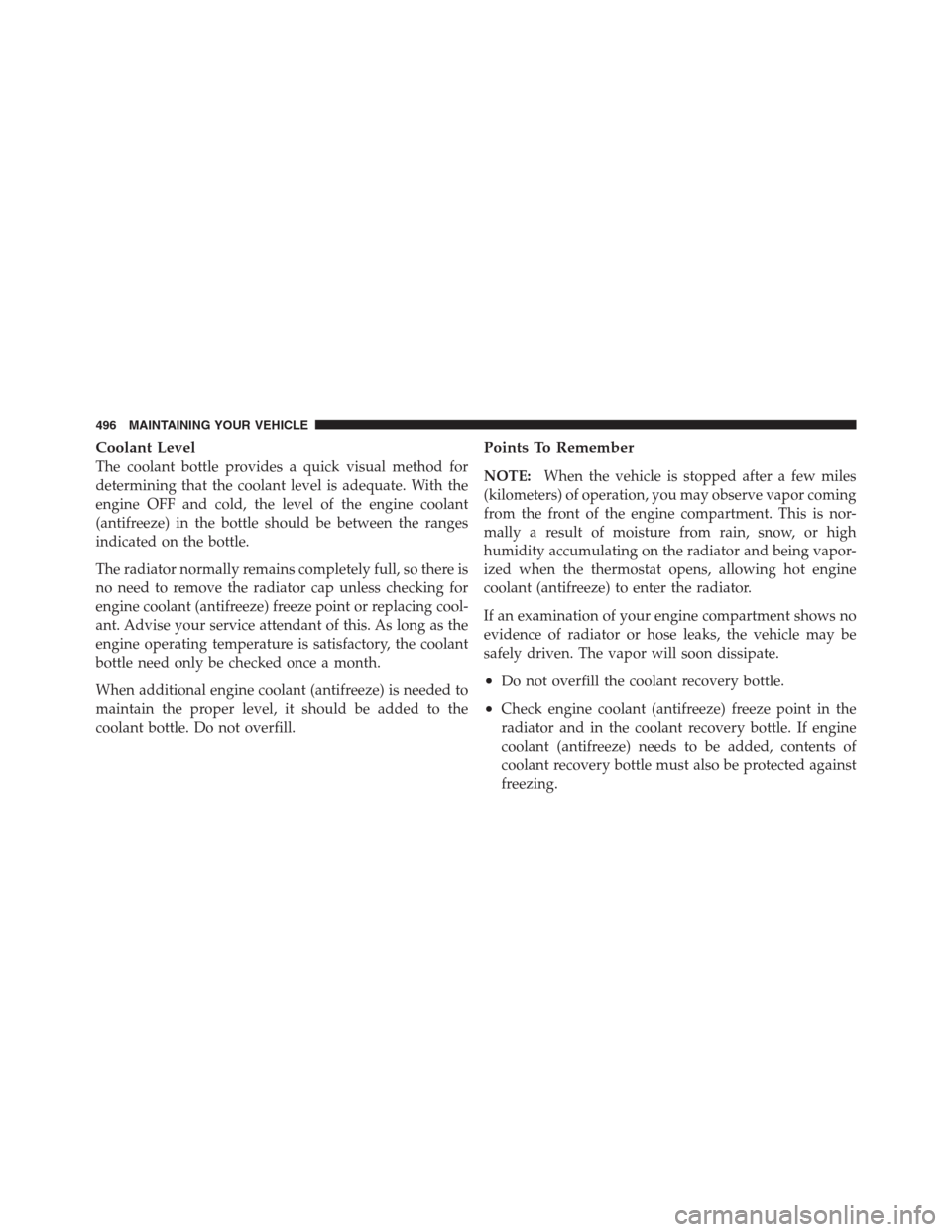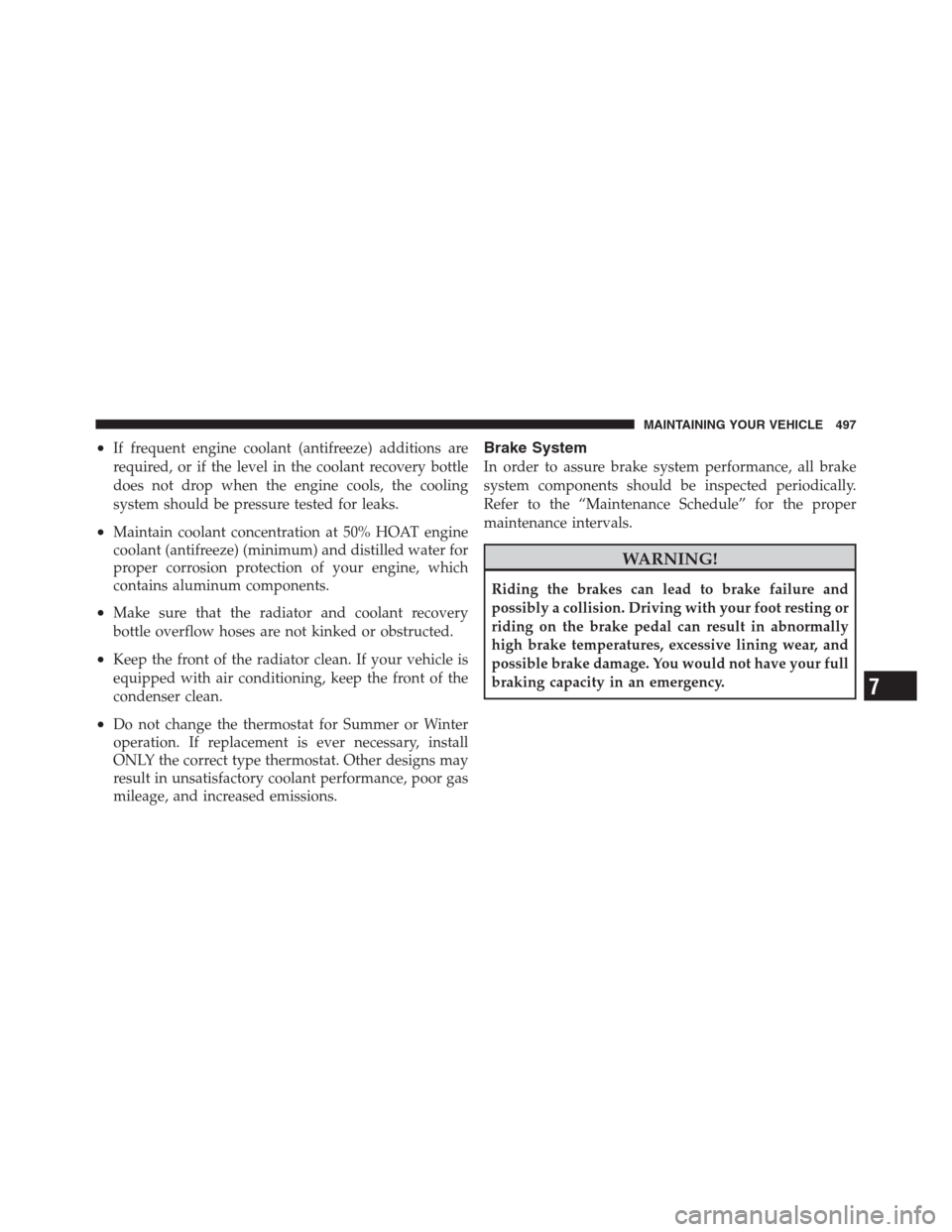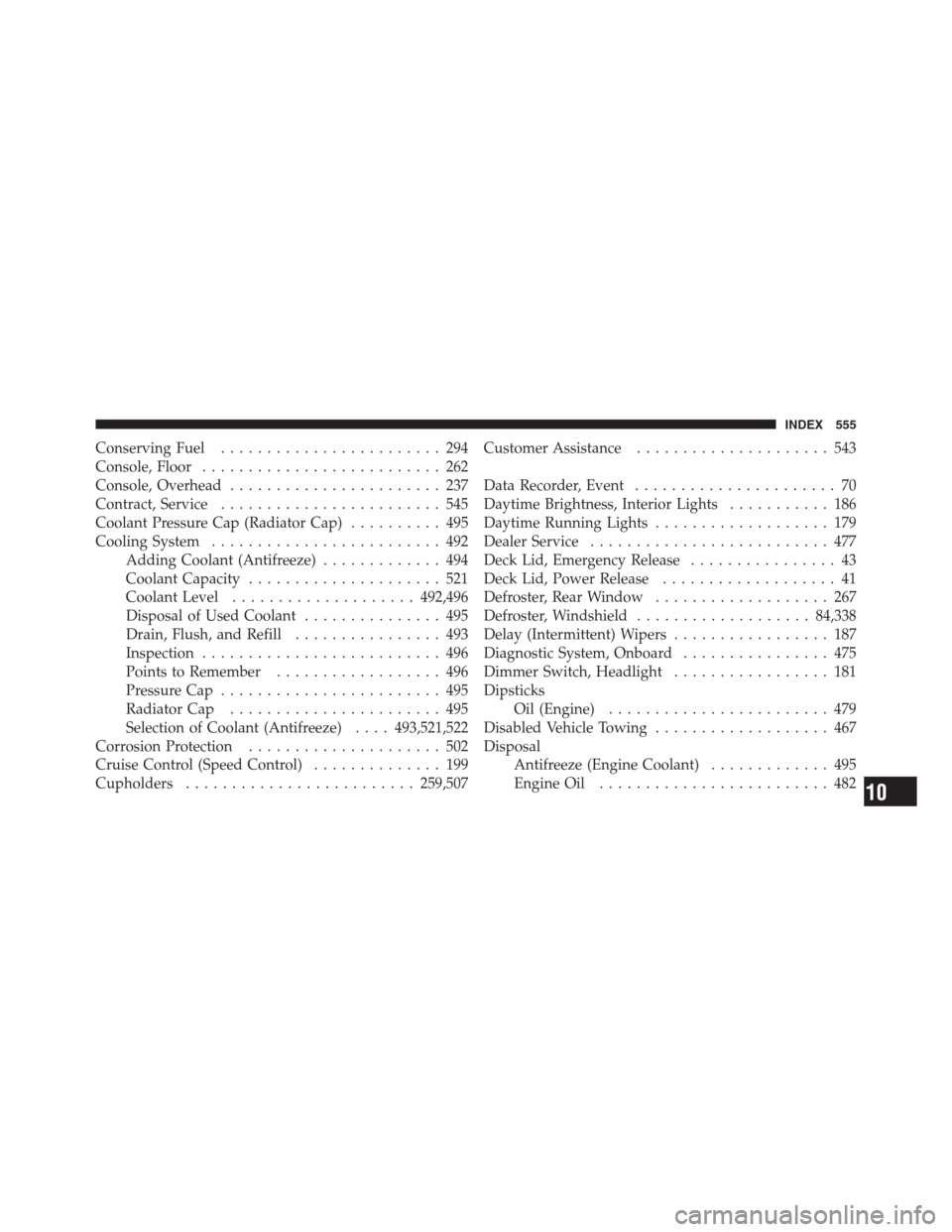2012 CHRYSLER 300 radiator cap
[x] Cancel search: radiator capPage 451 of 576

CAUTION!
Driving with a hot cooling system could damage
your vehicle. If the temperature gauge reads “H,”
pull over and stop the vehicle. Idle the vehicle with
the air conditioner turned off until the pointer drops
back into the normal range. If the pointer remains on
the “H,” turn the engine off immediately and call for
service.
WARNING!
You or others can be badly burned by hot engine
coolant (antifreeze) or steam from your radiator. If
you see or hear steam coming from under the hood,
do not open the hood until the radiator has had time
to cool. Never try to open a cooling system pressure
cap when the radiator or coolant bottle is hot.
JACKING AND TIRE CHANGING
WARNING!
•Do not attempt to change a tire on the side of the
vehicle close to moving traffic. Pull far enough off
the road to avoid the danger of being hit when
operating the jack or changing the wheel.
•Being under a jacked-up vehicle is dangerous. The
vehicle could slip off the jack and fall on you. You
could be crushed. Never put any part of your body
under a vehicle that is on a jack. If you need to get
under a raised vehicle, take it to a service center
where it can be raised on a lift.
•Never start or run the engine while the vehicle is
on a jack.
(Continued)
6
WHAT TO DO IN EMERGENCIES 449
Page 494 of 576

Cooling System
WARNING!
•When working near the radiator cooling fan, dis-
connect the fan motor lead or turn the ignition
switch to the LOCK position. The fan is tempera-
ture controlled and can start at any time the
ignition switch is in the ON position.
•You or others can be badly burned by hot engine
coolant (antifreeze) or steam from your radiator. If
you see or hear steam coming from under the
hood, do not open the hood until the radiator has
had time to cool. Never try to open a cooling
system pressure cap when the radiator is hot.
Coolant Checks
Check engine coolant (antifreeze) protection every
12 months (before the onset of freezing weather, where
applicable). If the engine coolant (antifreeze) is dirty orrusty in appearance, the system should be drained,
flushed, and refilled with fresh coolant. Check the front
of the radiator for any accumulation of bugs, leaves, etc.
If dirty, clean by gently spraying water from a garden
hose vertically down the face of the condenser.
Check the coolant recovery bottle tubing for brittle rub-
ber, cracking, tears, cuts, and tightness of the connection
at the bottle and radiator. Inspect the entire system for
leaks.
With the engine at normal operating temperature (but
not running), check the cooling system pressure cap for
proper vacuum sealing by draining a small amount of
engine coolant (antifreeze) from the radiator drain cock.
If the cap is sealing properly, the engine coolant (anti-
freeze) will begin to drain from the coolant recovery
bottle. DO NOT REMOVE THE COOLANT PRESSURE
CAP WHEN THE COOLING SYSTEM IS HOT.
492 MAINTAINING YOUR VEHICLE
Page 497 of 576

Cooling System Pressure Cap
The cap must be fully tightened to prevent loss of coolant,
and to ensure that engine coolant (antifreeze) will return to
the radiator from the coolant recovery bottle.
The cap should be inspected and cleaned if there is any
accumulation of foreign material on the sealing surfaces.
WARNING!
•The warning words “DO NOT OPEN HOT” on the
cooling system pressure cap are a safety precaution.
Never add engine coolant (antifreeze) when the
engine is overheated. Do not loosen or remove the
cap to cool an overheated engine. Heat causes pres-
sure to build up in the cooling system. To prevent
scalding or injury, do not remove the pressure cap
while the system is hot or under pressure.
(Continued)
WARNING! (Continued)
•Do not use a pressure cap other than the one
specified for your vehicle. Personal injury or en-
gine damage may result.
Disposal Of Used Coolant
Used ethylene glycol-based engine coolant (antifreeze) is
a regulated substance requiring proper disposal. Check
with your local authorities to determine the disposal
rules for your community. To prevent ingestion by ani-
mals or children, do not store ethylene glycol-based
engine coolant (antifreeze) in open containers or allow it
to remain in puddles on the ground. If ingested by a child
or pet, seek emergency assistance immediately. Clean up
any ground spills immediately.
7
MAINTAINING YOUR VEHICLE 495
Page 498 of 576

Coolant Level
The coolant bottle provides a quick visual method for
determining that the coolant level is adequate. With the
engine OFF and cold, the level of the engine coolant
(antifreeze) in the bottle should be between the ranges
indicated on the bottle.
The radiator normally remains completely full, so there is
no need to remove the radiator cap unless checking for
engine coolant (antifreeze) freeze point or replacing cool-
ant. Advise your service attendant of this. As long as the
engine operating temperature is satisfactory, the coolant
bottle need only be checked once a month.
When additional engine coolant (antifreeze) is needed to
maintain the proper level, it should be added to the
coolant bottle. Do not overfill.
Points To Remember
NOTE:When the vehicle is stopped after a few miles
(kilometers) of operation, you may observe vapor coming
from the front of the engine compartment. This is nor-
mally a result of moisture from rain, snow, or high
humidity accumulating on the radiator and being vapor-
ized when the thermostat opens, allowing hot engine
coolant (antifreeze) to enter the radiator.
If an examination of your engine compartment shows no
evidence of radiator or hose leaks, the vehicle may be
safely driven. The vapor will soon dissipate.
•Do not overfill the coolant recovery bottle.
•Check engine coolant (antifreeze) freeze point in the
radiator and in the coolant recovery bottle. If engine
coolant (antifreeze) needs to be added, contents of
coolant recovery bottle must also be protected against
freezing.
496 MAINTAINING YOUR VEHICLE
Page 499 of 576

•If frequent engine coolant (antifreeze) additions are
required, or if the level in the coolant recovery bottle
does not drop when the engine cools, the cooling
system should be pressure tested for leaks.
•Maintain coolant concentration at 50% HOAT engine
coolant (antifreeze) (minimum) and distilled water for
proper corrosion protection of your engine, which
contains aluminum components.
•Make sure that the radiator and coolant recovery
bottle overflow hoses are not kinked or obstructed.
•Keep the front of the radiator clean. If your vehicle is
equipped with air conditioning, keep the front of the
condenser clean.
•Do not change the thermostat for Summer or Winter
operation. If replacement is ever necessary, install
ONLY the correct type thermostat. Other designs may
result in unsatisfactory coolant performance, poor gas
mileage, and increased emissions.
Brake System
In order to assure brake system performance, all brake
system components should be inspected periodically.
Refer to the “Maintenance Schedule” for the proper
maintenance intervals.
WARNING!
Riding the brakes can lead to brake failure and
possibly a collision. Driving with your foot resting or
riding on the brake pedal can result in abnormally
high brake temperatures, excessive lining wear, and
possible brake damage. You would not have your full
braking capacity in an emergency.
7
MAINTAINING YOUR VEHICLE 497
Page 556 of 576

Brightness, Interior Lights.................. 184
Bulb Replacement.....................516,517
Bulbs, Light..........................86,516
Camera, Rear........................... 235
Capacities, Fluid........................ 521
Caps, Filler
Oil (Engine)........................ 481
Radiator (Coolant Pressure)............. 495
Car Washes............................ 503
Carbon Monoxide Warning...............83,424
Cargo (Vehicle Loading)................... 431
Cellular Phone.......................... 332
Certification Label....................... 431
Chains, Tire............................ 406
Changing A Flat Tire..................... 449
Chart, Tire Sizing........................ 389
Check Engine Light
(Malfunction Indicator Light).............279,475Checking Your Vehicle For Safety............. 82
Checks, Safety........................... 82
Child Restraint..................71,72,73,76,79
Child Restraint Tether Anchors.............75,76
Child Safety Locks........................ 32
Clean Air Gasoline....................... 421
Cleaning
Wheels............................ 504
Windshield Wiper Blades............... 488
Climate Control......................... 332
Clock................................ 328
Coin Holder........................... 262
Cold Weather Operation................... 351
Compact Disc (CD) Maintenance............. 331
Compact Spare Tire...................... 401
Computer, Trip/Travel.................... 297
Connector
UCI .............................. 328
Universal Consumer Interface (UCI)....... 328
554 INDEX
Page 557 of 576

Conserving Fuel........................ 294
Console, Floor.......................... 262
Console, Overhead....................... 237
Contract, Service........................ 545
Coolant Pressure Cap (Radiator Cap).......... 495
Cooling System......................... 492
Adding Coolant (Antifreeze)............. 494
Coolant Capacity..................... 521
Coolant Level....................492,496
Disposal of Used Coolant............... 495
Drain, Flush, and Refill................ 493
Inspection.......................... 496
Points to Remember.................. 496
Pressure Cap........................ 495
Radiator Cap....................... 495
Selection of Coolant (Antifreeze)....493,521,522
Corrosion Protection..................... 502
Cruise Control (Speed Control).............. 199
Cupholders.........................259,507Customer Assistance..................... 543
Data Recorder, Event...................... 70
Daytime Brightness, Interior Lights........... 186
Daytime Running Lights................... 179
Dealer Service.......................... 477
Deck Lid, Emergency Release................ 43
Deck Lid, Power Release................... 41
Defroster, Rear Window................... 267
Defroster, Windshield...................84,338
Delay (Intermittent) Wipers................. 187
Diagnostic System, Onboard................ 475
Dimmer Switch, Headlight................. 181
Dipsticks
Oil (Engine)........................ 479
Disabled Vehicle Towing................... 467
Disposal
Antifreeze (Engine Coolant)............. 495
Engine Oil......................... 482
10
INDEX 555
Page 567 of 576

Paint Care............................. 502
Panic Alarm............................ 24
Park Sense System, Rear................... 225
Parking Brake.......................... 375
Passing Light........................... 181
Pedals, Adjustable....................... 194
Pets.................................. 81
Placard, Tire and Loading Information......... 393
Power
Deck Lid Release..................... 41
Distribution Center (Fuses)...........508,511
Door Locks......................... 31
Mirrors............................ 97
Outlet (Auxiliary Electrical Outlet)........ 254
Seats............................. 157
Steering........................... 373
Sunroof.........................247,251
Tilt/Telescoping Steering Column......... 191
Windows........................... 38Power Steering Fluid..................... 523
Pregnant Women and Seat Belts.............. 56
Preparation for Jacking.................... 452
Pretensioners
Seat Belts........................... 54
Programming Transmitters
(Remote Keyless Entry).................... 21
Radial Ply Tires......................... 400
Radiator Cap (Coolant Pressure Cap).......... 495
Radio Operation........................ 332
Radio Remote Controls.................... 330
Rain Sensitive Wiper System................ 189
Rear Camera........................... 235
Rear Cupholder......................... 261
Rear Park Sense System................... 225
Rear Seat, Folding....................... 168
Rear Window Defroster................... 267
Rear Window Features.................... 267
10
INDEX 565